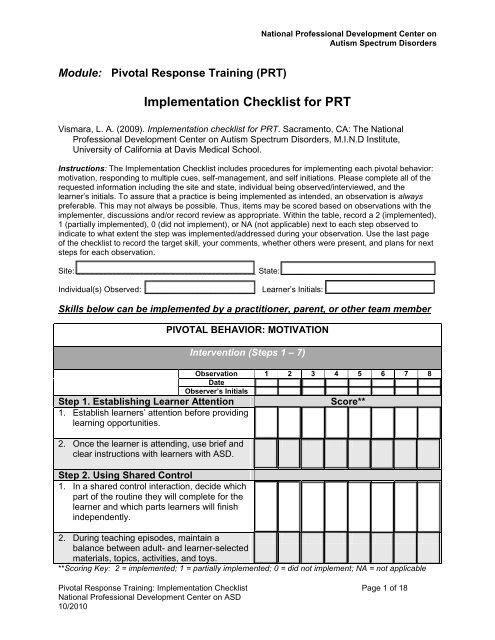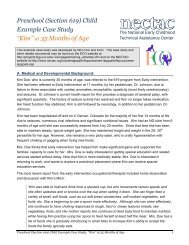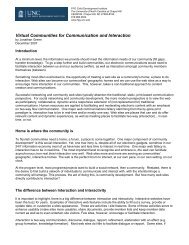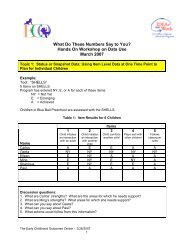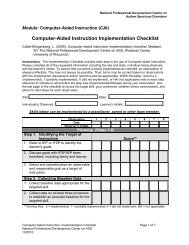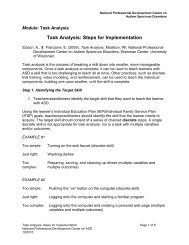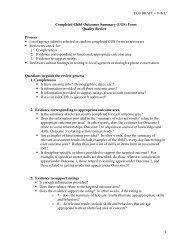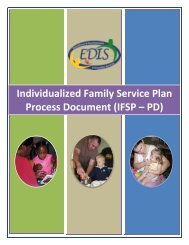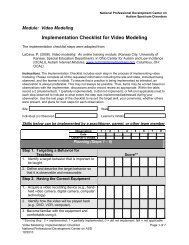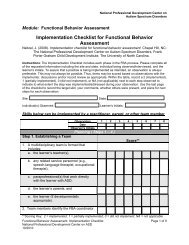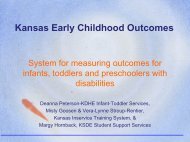Implementation Checklist for PRT - National Professional ...
Implementation Checklist for PRT - National Professional ...
Implementation Checklist for PRT - National Professional ...
Create successful ePaper yourself
Turn your PDF publications into a flip-book with our unique Google optimized e-Paper software.
<strong>National</strong> <strong>Professional</strong> Development Center on<br />
Autism Spectrum Disorders<br />
Module: Pivotal Response Training (<strong>PRT</strong>)<br />
<strong>Implementation</strong> <strong>Checklist</strong> <strong>for</strong> <strong>PRT</strong><br />
Vismara, L. A. (2009). <strong>Implementation</strong> checklist <strong>for</strong> <strong>PRT</strong>. Sacramento, CA: The <strong>National</strong><br />
<strong>Professional</strong> Development Center on Autism Spectrum Disorders, M.I.N.D Institute,<br />
University of Cali<strong>for</strong>nia at Davis Medical School.<br />
Instructions: The <strong>Implementation</strong> <strong>Checklist</strong> includes procedures <strong>for</strong> implementing each pivotal behavior:<br />
motivation, responding to multiple cues, self-management, and self initiations. Please complete all of the<br />
requested in<strong>for</strong>mation including the site and state, individual being observed/interviewed, and the<br />
learner’s initials. To assure that a practice is being implemented as intended, an observation is always<br />
preferable. This may not always be possible. Thus, items may be scored based on observations with the<br />
implementer, discussions and/or record review as appropriate. Within the table, record a 2 (implemented),<br />
1 (partially implemented), 0 (did not implement), or NA (not applicable) next to each step observed to<br />
indicate to what extent the step was implemented/addressed during your observation. Use the last page<br />
of the checklist to record the target skill, your comments, whether others were present, and plans <strong>for</strong> next<br />
steps <strong>for</strong> each observation.<br />
Site: ________________________________________ State: _________________________________<br />
Individual(s) Observed: ________________________ Learner’s Initials: ________________________<br />
Skills below can be implemented by a practitioner, parent, or other team member<br />
PIVOTAL BEHAVIOR: MOTIVATION<br />
Intervention (Steps 1 – 7)<br />
Step 1. Establishing Learner Attention<br />
1. Establish learners’ attention be<strong>for</strong>e providing<br />
learning opportunities.<br />
2. Once the learner is attending, use brief and<br />
clear instructions with learners with ASD.<br />
Step 2. Using Shared Control<br />
1. In a shared control interaction, decide which<br />
part of the routine they will complete <strong>for</strong> the<br />
learner and which parts learners will finish<br />
independently.<br />
Observation 1 2 3 4 5 6 7 8<br />
Date<br />
Observer’s Initials<br />
Score**<br />
2. During teaching episodes, maintain a<br />
balance between adult- and learner-selected<br />
materials, topics, activities, and toys.<br />
**Scoring Key: 2 = implemented; 1 = partially implemented; 0 = did not implement; NA = not applicable<br />
Pivotal Response Training: <strong>Implementation</strong> <strong>Checklist</strong> Page 1 of 18<br />
<strong>National</strong> <strong>Professional</strong> Development Center on ASD<br />
10/2010
<strong>National</strong> <strong>Professional</strong> Development Center on<br />
Autism Spectrum Disorders<br />
Module: Pivotal Response Training (<strong>PRT</strong>)<br />
Step 3. Using Learner Choice<br />
1. Observe learners when they have free<br />
access to materials to identify their<br />
preferences <strong>for</strong> items, activities, and toys.<br />
2. Arrange the environment with learnerpreferred,<br />
age-appropriate objects and<br />
activities.<br />
3. Allow learners to select materials, topics,<br />
and toys during teaching activities.<br />
4. Follow the learner’s lead during interactions<br />
and learning activities.<br />
5. Incorporate choice-making opportunities into<br />
naturally occurring routines and activities<br />
throughout the day.<br />
6. Provide a variety of activities and items <strong>for</strong><br />
learners to choose from throughout the day<br />
to increase their motivation to participate in<br />
numerous learning activities.<br />
Step 4. Varying Tasks<br />
1. Vary tasks, materials, and activities to<br />
maintain learner interest and engagement.<br />
2. Vary instructions and environmental<br />
conditions to foster learner response to a<br />
range of stimuli.<br />
Observation 1 2 3 4 5 6 7 8<br />
Date<br />
Observer’s Initials<br />
Score**<br />
**Scoring Key: 2 = implemented; 1 = partially implemented; 0 = did not implement; NA = not applicable<br />
Pivotal Response Training: <strong>Implementation</strong> <strong>Checklist</strong> Page 2 of 18<br />
<strong>National</strong> <strong>Professional</strong> Development Center on ASD<br />
10/2010
<strong>National</strong> <strong>Professional</strong> Development Center on<br />
Autism Spectrum Disorders<br />
Module: Pivotal Response Training (<strong>PRT</strong>)<br />
Step 5. Interspersing Acquisition and<br />
Maintenance Tasks<br />
1. Identify skills that are easy <strong>for</strong> learners and<br />
skills that are more difficult.<br />
2. Provide a mixture of easy and more difficult<br />
tasks so that learners can be successful at<br />
using a variety of skills.<br />
3. To facilitate maintenance of previously<br />
learned target skills, provide:<br />
a. short requests that are easy and within<br />
the learner’s repertoire of skills to<br />
complete followed by<br />
b. one or two requests that are more<br />
difficult <strong>for</strong> the learner to complete.<br />
Step 6. Rein<strong>for</strong>cing Response Attempts<br />
1. Rein<strong>for</strong>ce all verbal attempts at responding<br />
that are clear, unambiguous, and goaldirected.<br />
2. Provide rein<strong>for</strong>cement immediately after a<br />
goal-directed attempt.<br />
Step 7. Using Natural and Direct<br />
Rein<strong>for</strong>cers<br />
1. Identify materials and activities that can be<br />
used to address a learner’s goal during a<br />
teaching opportunity.<br />
Observation 1 2 3 4 5 6 7 8<br />
Date<br />
Observer’s Initials<br />
Score**<br />
2. Implement a learning task that is functionally<br />
and directly related to a learner’s goal.<br />
**Scoring Key: 2 = implemented; 1 = partially implemented; 0 = did not implement; NA = not applicable<br />
Pivotal Response Training: <strong>Implementation</strong> <strong>Checklist</strong> Page 3 of 18<br />
<strong>National</strong> <strong>Professional</strong> Development Center on ASD<br />
10/2010
<strong>National</strong> <strong>Professional</strong> Development Center on<br />
Autism Spectrum Disorders<br />
Module: Pivotal Response Training (<strong>PRT</strong>)<br />
<strong>Implementation</strong> <strong>Checklist</strong> <strong>for</strong> <strong>PRT</strong><br />
Vismara, L. A. (2009). <strong>Implementation</strong> checklist <strong>for</strong> <strong>PRT</strong>. Sacramento, CA: The <strong>National</strong><br />
<strong>Professional</strong> Development Center on Autism Spectrum Disorders, M.I.N.D Institute,<br />
University of Cali<strong>for</strong>nia at Davis Medical School<br />
Instructions: The <strong>Implementation</strong> <strong>Checklist</strong> includes procedures <strong>for</strong> implementing each pivotal behavior.<br />
Please complete all of the requested in<strong>for</strong>mation including the site and state, individual being<br />
observed/interviewed, and the learner’s initials. To assure that a practice is being implemented as<br />
intended, an observation is always preferable. This may not always be possible. Thus, items may be<br />
scored based on observations with the implementer, discussions and/or record review as appropriate.<br />
Within the table, record a 2 (implemented), 1 (partially implemented), 0 (did not implement), or NA (not<br />
applicable) next to each step observed to indicate to what extent the step was implemented/addressed<br />
during your observation. Use the last page of the checklist to record the target skill, your comments,<br />
whether others were present, and plans <strong>for</strong> next steps <strong>for</strong> each observation.<br />
Site: ________________________________________ State: _________________________________<br />
Individual(s) Observed: ________________________ Learner’s Initials: ________________________<br />
Skills below can be implemented by a practitioner, parent, or other team member<br />
PIVOTAL BEHAVIOR: RESPONDING TO MULTIPLE CUES<br />
Planning and Intervention (Steps 1 – 2)<br />
Step 1. Varying Stimuli and Increasing<br />
Cues<br />
1. Identify a variety of cues that are associated<br />
with the target skill and that can be used<br />
during a teaching activity.<br />
2. Provide at least two cues (e.g.,<br />
overemphasizing feature of object, color,<br />
size, type of object, location of object) so that<br />
learners begin to use the target skill in<br />
response to more than one cue.<br />
3. Gradually increase the number of cues<br />
associated with a particular object, material,<br />
or toy so that learners are able to respond to<br />
a variety of stimuli.<br />
Observation 1 2 3 4 5 6 7 8<br />
Date<br />
Observer’s Initials<br />
Score**<br />
**Scoring Key: 2 = implemented; 1 = partially implemented; 0 = did not implement; NA = not applicable<br />
Pivotal Response Training: <strong>Implementation</strong> <strong>Checklist</strong> Page 4 of 18<br />
<strong>National</strong> <strong>Professional</strong> Development Center on ASD<br />
10/2010
<strong>National</strong> <strong>Professional</strong> Development Center on<br />
Autism Spectrum Disorders<br />
Module: Pivotal Response Training (<strong>PRT</strong>)<br />
Observation 1 2 3 4 5 6 7 8<br />
Date<br />
Observer’s Initials<br />
Step 2. Scheduling the Rein<strong>for</strong>cement<br />
1. Identify numerous rein<strong>for</strong>cers that can be<br />
used to increase learners’ motivation to use<br />
the target skill.<br />
2. Provide rein<strong>for</strong>cement <strong>for</strong> every attempt to<br />
use the target skill successfully (continuous<br />
schedule).<br />
3. Move from a continuous schedule to a<br />
variable ratio schedule of rein<strong>for</strong>cement<br />
(e.g., one out of every three responses).<br />
**Scoring Key: 2 = implemented; 1 = partially implemented; 0 = did not implement; NA = not applicable<br />
Pivotal Response Training: <strong>Implementation</strong> <strong>Checklist</strong> Page 5 of 18<br />
<strong>National</strong> <strong>Professional</strong> Development Center on ASD<br />
10/2010
<strong>National</strong> <strong>Professional</strong> Development Center on<br />
Autism Spectrum Disorders<br />
Module: Pivotal Response Training (<strong>PRT</strong>)<br />
<strong>Implementation</strong> <strong>Checklist</strong> <strong>for</strong> <strong>PRT</strong><br />
Vismara, L. A. (2009). <strong>Implementation</strong> checklist <strong>for</strong> <strong>PRT</strong>. Sacramento, CA: The <strong>National</strong><br />
<strong>Professional</strong> Development Center on Autism Spectrum Disorders, M.I.N.D Institute,<br />
University of Cali<strong>for</strong>nia at Davis Medical School<br />
Instructions: The <strong>Implementation</strong> <strong>Checklist</strong> includes procedures that are used to implement each pivotal<br />
behavior. Please complete all of the requested in<strong>for</strong>mation including the site and state, individual being<br />
observed/interviewed, and the learner’s initials. To assure that a practice is being implemented as<br />
intended, an observation is always preferable. This may not always be possible. Thus, items may be<br />
scored based on observations with the implementer, discussions and/or record review as appropriate.<br />
Within the table, record a 2 (implemented), 1 (partially implemented), 0 (did not implement), or NA (not<br />
applicable) next to each step observed to indicate to what extent the step was implemented/addressed<br />
during your observation. Use the last page of the checklist to record the target skill, your comments,<br />
whether others were present, and plans <strong>for</strong> next steps <strong>for</strong> each observation.<br />
Site: ________________________________________ State: _________________________________<br />
Individual(s) Observed: ________________________ Learner’s Initials: ________________________<br />
Skills below can be implemented by a practitioner, parent, or other team member<br />
PIVOTAL BEHAVIOR: SELF-MANAGEMENT TO INCREASE POSITIVE BEHAVIORS<br />
Observation 1 2 3 4 5 6 7 8<br />
Date<br />
Observer’s Initials<br />
Planning (Step 1)<br />
Step 1. Preparing the Self-Management<br />
System<br />
1. Clearly define the target behavior in terms<br />
that are specific, observable, and<br />
measurable and include a specific criterion<br />
<strong>for</strong> receiving rein<strong>for</strong>cement.<br />
2. Collect frequency and duration data be<strong>for</strong>e<br />
the self-management system is implemented<br />
to establish a baseline or current<br />
per<strong>for</strong>mance of learners’ behavior.<br />
Score**<br />
3. Select items and activities that learners<br />
enjoy as rewards. If appropriate, learners<br />
should help identify rewards that they would<br />
like to earn.<br />
**Scoring Key: 2 = implemented; 1 = partially implemented; 0 = did not implement; NA = not applicable<br />
Pivotal Response Training: <strong>Implementation</strong> <strong>Checklist</strong> Page 6 of 18<br />
<strong>National</strong> <strong>Professional</strong> Development Center on ASD<br />
10/2010
<strong>National</strong> <strong>Professional</strong> Development Center on<br />
Autism Spectrum Disorders<br />
Module: Pivotal Response Training (<strong>PRT</strong>)<br />
Observation 1 2 3 4 5 6 7 8<br />
Date<br />
Observer’s Initials<br />
4. Determine how often (i.e., interval) learners<br />
should record their own behavior.<br />
5. Determine what monitoring device or system<br />
will be used to record successful behavior.<br />
Intervention (Steps 2 – 3)<br />
Step 2. Teaching Self-Management<br />
Score**<br />
1. Teach learners how to discriminate between<br />
desirable and undesirable behavior in<br />
language that learners understand.<br />
2. Teach learners to record whether their<br />
behavior was successful or unsuccessful<br />
across intervals.<br />
3. Provide learners with the specified rein<strong>for</strong>cer<br />
when the criterion has been reached.<br />
Step 3. Creating Independence<br />
1. Gradually increase the amount of time<br />
learners self-manage the target behavior by<br />
increasing the length of time between<br />
intervals.<br />
2. Gradually fade intensity and frequency of<br />
prompts as learners become more<br />
successful at managing their behavior.<br />
3. Increase the number of responses<br />
necessary <strong>for</strong> the rein<strong>for</strong>cer as learners<br />
become more successful at managing their<br />
behavior.<br />
**Scoring Key: 2 = implemented; 1 = partially implemented; 0 = did not implement; NA = not applicable<br />
Pivotal Response Training: <strong>Implementation</strong> <strong>Checklist</strong> Page 7 of 18<br />
<strong>National</strong> <strong>Professional</strong> Development Center on ASD<br />
10/2010
<strong>National</strong> <strong>Professional</strong> Development Center on<br />
Autism Spectrum Disorders<br />
Module: Pivotal Response Training (<strong>PRT</strong>)<br />
Observation 1 2 3 4 5 6 7 8<br />
Date<br />
Observer’s Initials<br />
4. Gradually reduce their presence as learners<br />
become more successful at managing their<br />
behavior and/or administering their own<br />
rein<strong>for</strong>cer.<br />
5. Teach learners self-management skills in<br />
additional settings and with other<br />
practitioners and family members.<br />
**Scoring Key: 2 = implemented; 1 = partially implemented; 0 = did not implement; NA = not applicable<br />
Pivotal Response Training: <strong>Implementation</strong> <strong>Checklist</strong> Page 8 of 18<br />
<strong>National</strong> <strong>Professional</strong> Development Center on ASD<br />
10/2010
<strong>National</strong> <strong>Professional</strong> Development Center on<br />
Autism Spectrum Disorders<br />
Module: Pivotal Response Training (<strong>PRT</strong>)<br />
<strong>Implementation</strong> <strong>Checklist</strong> <strong>for</strong> <strong>PRT</strong><br />
Vismara, L. A. (2009). <strong>Implementation</strong> checklist <strong>for</strong> <strong>PRT</strong>. Sacramento, CA: The <strong>National</strong><br />
<strong>Professional</strong> Development Center on Autism Spectrum Disorders, M.I.N.D Institute,<br />
University of Cali<strong>for</strong>nia at Davis Medical School<br />
Instructions: The <strong>Implementation</strong> <strong>Checklist</strong> includes procedures to implement each pivotal behavior.<br />
Please complete all of the requested in<strong>for</strong>mation including the site and state, individual being<br />
observed/interviewed, and the learner’s initials. To assure that a practice is being implemented as<br />
intended, an observation is always preferable. This may not always be possible. Thus, items may be<br />
scored based on observations with the implementer, discussions and/or record review as appropriate.<br />
Within the table, record a 2 (implemented), 1 (partially implemented), 0 (did not implement), or NA (not<br />
applicable) next to each step observed to indicate to what extent the step was implemented/addressed<br />
during your observation. Use the last page of the checklist to record the target skill, your comments,<br />
whether others were present, and plans <strong>for</strong> next steps <strong>for</strong> each observation.<br />
Site: ________________________________________ State: _________________________________<br />
Individual(s) Observed: ________________________ Learner’s Initials: ________________________<br />
Skills below can be implemented by a practitioner, parent, or other team member<br />
PIVOTAL BEHAVIOR: SELF-MANAGEMENT TO REDUCE INTERFERING<br />
BEHAVIOR AND TEACH POSITIVE REPLACEMENT BEHAVIORS<br />
Observation 1 2 3 4 5 6 7 8<br />
Date<br />
Observer’s Initials<br />
Planning (Steps 1 – 2)<br />
Step 1. Defining the Behavior<br />
1. Conduct a functional behavior assessment to<br />
identify, describe, and determine the function<br />
of interfering behaviors <strong>for</strong> individual learners<br />
with ASD.<br />
Step 2. Preparing the Self-Management<br />
System<br />
1. Assess potential replacement behaviors by<br />
determining:<br />
Score**<br />
a. the behavior the learner will use to attract<br />
the teacher’s attention,<br />
b. when he learner needs to use the<br />
behavior,<br />
**Scoring Key: 2 = implemented; 1 = partially implemented; 0 = did not implement; NA = not applicable<br />
Pivotal Response Training: <strong>Implementation</strong> <strong>Checklist</strong> Page 9 of 18<br />
<strong>National</strong> <strong>Professional</strong> Development Center on ASD<br />
10/2010
<strong>National</strong> <strong>Professional</strong> Development Center on<br />
Autism Spectrum Disorders<br />
Module: Pivotal Response Training (<strong>PRT</strong>)<br />
Observation 1 2 3 4 5 6 7 8<br />
Date<br />
Observer’s Initials<br />
c. whether the learner can independently<br />
use the behavior, and<br />
d. how the behavior will be measured.<br />
2. Select an appropriate replacement behavior<br />
to take the place of the interfering behavior.<br />
3. Clearly define the replacement behavior in<br />
terms that are specific, observable, and<br />
measurable.<br />
4. Identify a variety of meaningful rewards<br />
(some large and some small) <strong>for</strong> learners’<br />
use of replacement behaviors.<br />
5. Identify the overall goal and explain it to the<br />
learner with ASD in a developmentally- and<br />
age-appropriate way.<br />
6. Provide the learner with many opportunities<br />
to experience success with using the<br />
replacement behavior.<br />
Intervention (Steps 3 – 5)<br />
Step 3. Teaching Self-Management<br />
1. Teach learners how to discriminate between<br />
desirable and undesirable behavior in<br />
language that learners understand.<br />
2. Teach learners to record whether their<br />
behavior was successful or unsuccessful<br />
across intervals.<br />
3. Provide the learner with the specified reward<br />
when the criterion has been reached.<br />
Step 4. Creating Independence<br />
1. Gradually increase the amount of time<br />
learners self-manage the target behavior by<br />
increasing the length of time between<br />
intervals.<br />
**Scoring Key: 2 = implemented; 1 = partially implemented; 0 = did not implement; NA = not applicable<br />
Pivotal Response Training: <strong>Implementation</strong> <strong>Checklist</strong> Page 10 of 18<br />
<strong>National</strong> <strong>Professional</strong> Development Center on ASD<br />
10/2010
<strong>National</strong> <strong>Professional</strong> Development Center on<br />
Autism Spectrum Disorders<br />
Module: Pivotal Response Training (<strong>PRT</strong>)<br />
Step 4. Creating Independence (cont.)<br />
2. Gradually fade intensity and frequency of<br />
prompts as learners become more<br />
successful at managing their behavior.<br />
3. Increase the number of responses<br />
necessary to receive the rein<strong>for</strong>cer as<br />
learners become more successful at<br />
managing their behavior.<br />
4. Gradually reduce their presence as learners<br />
become more successful at managing their<br />
behavior and/or administering their own<br />
rein<strong>for</strong>cer.<br />
Step 5. Generalizing to Other Settings<br />
1. Teach learners self-management skills in a<br />
variety of settings and with other<br />
practitioners and family members.<br />
Observation 1 2 3 4 5 6 7 8<br />
Date<br />
Observer’s Initials<br />
Score**<br />
**Scoring Key: 2 = implemented; 1 = partially implemented; 0 = did not implement; NA = not applicable<br />
Pivotal Response Training: <strong>Implementation</strong> <strong>Checklist</strong> Page 11 of 18<br />
<strong>National</strong> <strong>Professional</strong> Development Center on ASD<br />
10/2010
<strong>National</strong> <strong>Professional</strong> Development Center on<br />
Autism Spectrum Disorders<br />
Module: Pivotal Response Training (<strong>PRT</strong>)<br />
<strong>Implementation</strong> <strong>Checklist</strong> <strong>for</strong> <strong>PRT</strong><br />
Vismara, L. A. (2009). <strong>Implementation</strong> checklist <strong>for</strong> <strong>PRT</strong>. Sacramento, CA: The <strong>National</strong><br />
<strong>Professional</strong> Development Center on Autism Spectrum Disorders, M.I.N.D Institute,<br />
University of Cali<strong>for</strong>nia at Davis Medical School<br />
Instructions: The <strong>Implementation</strong> <strong>Checklist</strong> includes procedures <strong>for</strong> implementing each pivotal behavior.<br />
Please complete all of the requested in<strong>for</strong>mation including the site and state, individual being<br />
observed/interviewed, and the learner’s initials. To assure that a practice is being implemented as<br />
intended, an observation is always preferable. This may not always be possible. Thus, items may be<br />
scored based on observations with the implementer, discussions and/or record review as appropriate.<br />
Within the table, record a 2 (implemented), 1 (partially implemented), 0 (did not implement), or NA (not<br />
applicable) next to each step observed to indicate to what extent the step was implemented/addressed<br />
during your observation. Use the last page of the checklist to record the target skill, your comments,<br />
whether others were present, and plans <strong>for</strong> next steps <strong>for</strong> each observation.<br />
Site: ________________________________________ State: _________________________________<br />
Individual(s) Observed: ________________________ Learner’s Initials: ________________________<br />
Skills below can be implemented by a practitioner, parent, or other team member<br />
PIVOTAL BEHAVIOR: PROMOTING SELF-INITIATIONS USING PEER-MEDIATED<br />
STRATEGIES<br />
Observation 1 2 3 4 5 6 7 8<br />
Date<br />
Observer’s Initials<br />
Intervention (Step 1)<br />
Step 1. Implementing Peer-Mediated<br />
Strategies<br />
1. Select typically developing peers who are<br />
compliant and motivated to participate in<br />
peer-mediated activities.<br />
Score**<br />
2. Teach typically developing peers how to:<br />
a. secure the learner’s attention be<strong>for</strong>e<br />
initiating a social exchange;<br />
b. provide the learner with ASD choices<br />
among activities and materials;<br />
c. vary materials according to the learner’s<br />
preference;<br />
**Scoring Key: 2 = implemented; 1 = partially implemented; 0 = did not implement; NA = not applicable<br />
Pivotal Response Training: <strong>Implementation</strong> <strong>Checklist</strong> Page 12 of 18<br />
<strong>National</strong> <strong>Professional</strong> Development Center on ASD<br />
10/2010
<strong>National</strong> <strong>Professional</strong> Development Center on<br />
Autism Spectrum Disorders<br />
Module: Pivotal Response Training (<strong>PRT</strong>)<br />
Step 1. Implementing Peer-Mediated<br />
Strategies (cont.)<br />
d. secure the learner’s attention be<strong>for</strong>e<br />
initiating a social exchange;<br />
e. provide the learner with ASD choices<br />
among activities and materials;<br />
f. vary materials according to the learner’s<br />
preference;<br />
g. provide frequent and varied models <strong>for</strong><br />
appropriate play and social skills;<br />
h. verbally rein<strong>for</strong>ce learner attempts at<br />
social interaction and/or functional,<br />
appropriate play;<br />
i. encourage conversation with the learner<br />
with ASD by withholding desired objects<br />
until an appropriate verbal response is<br />
given;<br />
j. ask questions or encourage conversation<br />
that are relevant to the routine or activity;<br />
k. take turns during play and other social<br />
interactions;<br />
l. describe what they are doing during<br />
activities, including comments to share<br />
the social experience; and/or<br />
Observation 1 2 3 4 5 6 7 8<br />
Date<br />
Observer’s Initials<br />
Score**<br />
m. describe objects as clearly as they can<br />
during routines and activities and<br />
encourage learners with ASD to do the<br />
same.<br />
**Scoring Key: 2 = implemented; 1 = partially implemented; 0 = did not implement; NA = not applicable<br />
Pivotal Response Training: <strong>Implementation</strong> <strong>Checklist</strong> Page 13 of 18<br />
<strong>National</strong> <strong>Professional</strong> Development Center on ASD<br />
10/2010
<strong>National</strong> <strong>Professional</strong> Development Center on<br />
Autism Spectrum Disorders<br />
Module: Pivotal Response Training (<strong>PRT</strong>)<br />
<strong>Implementation</strong> <strong>Checklist</strong> <strong>for</strong> <strong>PRT</strong><br />
Vismara, L. A. (2009). <strong>Implementation</strong> checklist <strong>for</strong> <strong>PRT</strong>. Sacramento, CA: The <strong>National</strong><br />
<strong>Professional</strong> Development Center on Autism Spectrum Disorders, M.I.N.D Institute,<br />
University of Cali<strong>for</strong>nia at Davis Medical School<br />
Instructions: The <strong>Implementation</strong> <strong>Checklist</strong> includes procedures <strong>for</strong> implementing each pivotal behavior.<br />
Please complete all of the requested in<strong>for</strong>mation including the site and state, individual being<br />
observed/interviewed, and the learner’s initials. To assure that a practice is being implemented as<br />
intended, an observation is always preferable. This may not always be possible. Thus, items may be<br />
scored based on observations with the implementer, discussions and/or record review as appropriate.<br />
Within the table, record a 2 (implemented), 1 (partially implemented), 0 (did not implement), or NA (not<br />
applicable) next to each step observed to indicate to what extent the step was implemented/addressed<br />
during your observation. Use the last page of the checklist to record the target skill, your comments,<br />
whether others were present, and plans <strong>for</strong> next steps <strong>for</strong> each observation.<br />
Site: ________________________________________ State: _________________________________<br />
Individual(s) Observed: ________________________ Learner’s Initials: ________________________<br />
Skills below can be implemented by a practitioner, parent, or other team member<br />
PIVOTAL BEHAVIOR: PROMOTING SELF-INITIATIONS USING LEARNER-<br />
INITIATED STRATEGIES<br />
Observation 1 2 3 4 5 6 7 8<br />
Date<br />
Observer’s Initials<br />
Intervention (Steps 1 – 4)<br />
Step 1. Teaching Social Initiations<br />
1. Teach the learner with ASD:<br />
Score**<br />
a. ways to initiate social interactions with<br />
others by sharing materials (e.g.,<br />
handing peer a block, and asking “Can I<br />
have some blocks”).<br />
b. how to organize play activities (e.g., “You<br />
build the road, I’ll build the bridge,”<br />
handing a peer a baseball glove while<br />
keeping the bat).<br />
**Scoring Key: 2 = implemented; 1 = partially implemented; 0 = did not implement; NA = not applicable<br />
Pivotal Response Training: <strong>Implementation</strong> <strong>Checklist</strong> Page 14 of 18<br />
<strong>National</strong> <strong>Professional</strong> Development Center on ASD<br />
10/2010
<strong>National</strong> <strong>Professional</strong> Development Center on<br />
Autism Spectrum Disorders<br />
Module: Pivotal Response Training (<strong>PRT</strong>)<br />
Step 1. Teaching Social Initiations (cont.)<br />
c. how to take turns choosing activities<br />
(e.g., choice board with peer, assigning a<br />
peer buddy and alternating turns<br />
choosing activities and/or materials).<br />
d. how to be persistent when trying to<br />
initiate with others (e.g., using different<br />
attention-getting and repair strategies if<br />
initial ef<strong>for</strong>ts are rejected).<br />
2. Provide learners with opportunities to<br />
practice skills be<strong>for</strong>e using them with peers.<br />
Step 2. Teaching Question-Asking:<br />
“What’s That”<br />
1. Place highly preferred objects, items,<br />
materials in an opaque bag.<br />
2. Prompt the learner with ASD to ask, “What’s<br />
that”<br />
3. Show learners what is inside the bag and<br />
give them immediate access to the item (i.e.,<br />
learner does not have to make an additional<br />
request <strong>for</strong> item.)<br />
4. Gradually fade prompts as learners with<br />
ASD spontaneously ask the question,<br />
“What’s that”<br />
5. Gradually replace preferred items in the bag<br />
with less preferred and unfamiliar items.<br />
6. Gradually fade the use of the opaque bag<br />
when learners spontaneously ask the<br />
question, “What’s that”<br />
7. Encourage generalization by placing items in<br />
other objects or locations (e.g., boxes, in<br />
hands).<br />
Observation 1 2 3 4 5 6 7 8<br />
Date<br />
Observer’s Initials<br />
Score**<br />
**Scoring Key: 2 = implemented; 1 = partially implemented; 0 = did not implement; NA = not applicable<br />
Pivotal Response Training: <strong>Implementation</strong> <strong>Checklist</strong> Page 15 of 18<br />
<strong>National</strong> <strong>Professional</strong> Development Center on ASD<br />
10/2010
<strong>National</strong> <strong>Professional</strong> Development Center on<br />
Autism Spectrum Disorders<br />
Module: Pivotal Response Training (<strong>PRT</strong>)<br />
Observation 1 2 3 4 5 6 7 8<br />
Date<br />
Observer’s Initials<br />
Step 3. Teaching Question-Asking:<br />
“What Happened” and “What’s<br />
Happening”<br />
1. Select pop-up books that are related to<br />
learners’ interests.<br />
2. Prompt learners to either ask, “What’s<br />
happening” or “What happened” after they<br />
pull the tab <strong>for</strong> the pop-up pictures.<br />
3. Once learners ask a question, model the<br />
correct verb ending (“dog is jumping” or “dog<br />
jumped”) and give learners a turn to pull the<br />
tab.<br />
Step 4. Teaching Language,<br />
Communication, and Social Skills<br />
Using Naturalistic Techniques<br />
1. Imitate learners’ actions during interactions,<br />
play, and other activities.<br />
2. Provide the learner with the appropriate item<br />
after it is requested.<br />
3. Provide a task demand, then wait <strong>for</strong> the<br />
learner to respond independently be<strong>for</strong>e<br />
providing a prompt.<br />
4. Place preferred items out of reach to<br />
encourage independent requesting by the<br />
learner with ASD.<br />
**Scoring Key: 2 = implemented; 1 = partially implemented; 0 = did not implement; NA = not applicable<br />
Pivotal Response Training: <strong>Implementation</strong> <strong>Checklist</strong> Page 16 of 18<br />
<strong>National</strong> <strong>Professional</strong> Development Center on ASD<br />
10/2010
<strong>National</strong> <strong>Professional</strong> Development Center on<br />
Autism Spectrum Disorders<br />
Module: Pivotal Response Training (<strong>PRT</strong>)<br />
Date<br />
Observer<br />
Initials<br />
Target Skill/Behavior, Comments, and Plans <strong>for</strong> Next Steps<br />
Date<br />
Observer<br />
Initials<br />
Target Skill/Behavior, Comments, and Plans <strong>for</strong> Next Steps<br />
Date<br />
Observer<br />
Initials<br />
Target Skill/Behavior, Comments, and Plans <strong>for</strong> Next Steps<br />
Date<br />
Observer<br />
Initials<br />
Target Skill/Behavior, Comments, and Plans <strong>for</strong> Next Steps<br />
Pivotal Response Training: <strong>Implementation</strong> <strong>Checklist</strong> Page 17 of 18<br />
<strong>National</strong> <strong>Professional</strong> Development Center on ASD<br />
10/2010
<strong>National</strong> <strong>Professional</strong> Development Center on<br />
Autism Spectrum Disorders<br />
Module: Pivotal Response Training (<strong>PRT</strong>)<br />
Date<br />
Observer<br />
Initials<br />
Target Skill/Behavior, Comments, and Plans <strong>for</strong> Next Steps<br />
Date<br />
Observer<br />
Initials<br />
Target Skill/Behavior, Comments, and Plans <strong>for</strong> Next Steps<br />
Date<br />
Observer<br />
Initials<br />
Target Skill/Behavior, Comments, and Plans <strong>for</strong> Next Steps<br />
Date<br />
Observer<br />
Initials<br />
Target Skill/Behavior, Comments, and Plans <strong>for</strong> Next Steps<br />
Pivotal Response Training: <strong>Implementation</strong> <strong>Checklist</strong> Page 18 of 18<br />
<strong>National</strong> <strong>Professional</strong> Development Center on ASD<br />
10/2010


